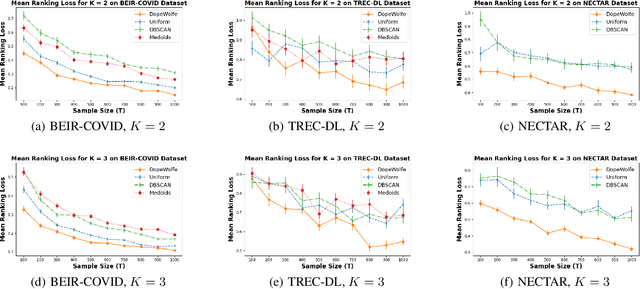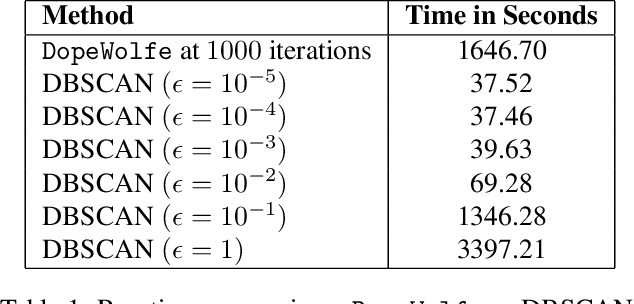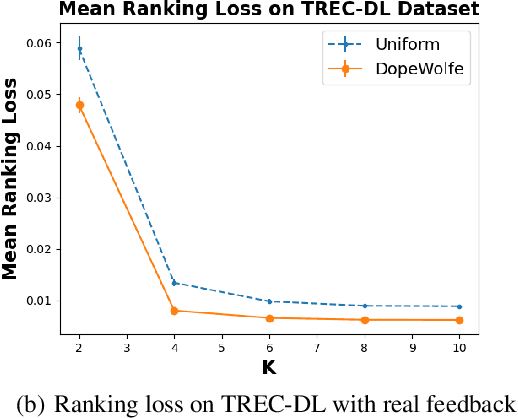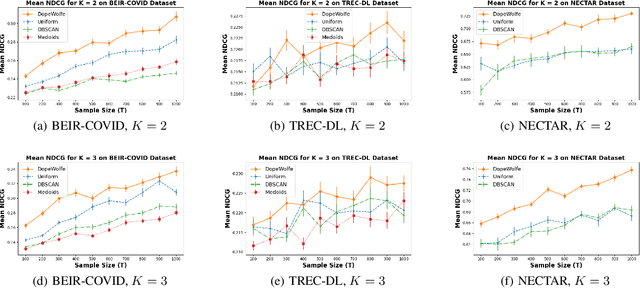Shoham Sabach
FisherSFT: Data-Efficient Supervised Fine-Tuning of Language Models Using Information Gain
May 20, 2025Abstract:Supervised fine-tuning (SFT) is a standard approach to adapting large language models (LLMs) to new domains. In this work, we improve the statistical efficiency of SFT by selecting an informative subset of training examples. Specifically, for a fixed budget of training examples, which determines the computational cost of fine-tuning, we determine the most informative ones. The key idea in our method is to select examples that maximize information gain, measured by the Hessian of the log-likelihood of the LLM. We approximate it efficiently by linearizing the LLM at the last layer using multinomial logistic regression models. Our approach is computationally efficient, analyzable, and performs well empirically. We demonstrate this on several problems, and back our claims with both quantitative results and an LLM evaluation.
C-3DPO: Constrained Controlled Classification for Direct Preference Optimization
Feb 22, 2025Abstract:Direct preference optimization (DPO)-style algorithms have emerged as a promising approach for solving the alignment problem in AI. We present a novel perspective that formulates these algorithms as implicit classification algorithms. This classification framework enables us to recover many variants of DPO-style algorithms by choosing appropriate classification labels and loss functions. We then leverage this classification framework to demonstrate that the underlying problem solved in these algorithms is under-specified, making them susceptible to probability collapse of the winner-loser responses. We address this by proposing a set of constraints designed to control the movement of probability mass between the winner and loser in the reference and target policies. Our resulting algorithm, which we call Constrained Controlled Classification DPO (\texttt{C-3DPO}), has a meaningful RLHF interpretation. By hedging against probability collapse, \texttt{C-3DPO} provides practical improvements over vanilla \texttt{DPO} when aligning several large language models using standard preference datasets.
A Proximal Operator for Inducing 2:4-Sparsity
Jan 29, 2025



Abstract:Recent hardware advancements in AI Accelerators and GPUs allow to efficiently compute sparse matrix multiplications, especially when 2 out of 4 consecutive weights are set to zero. However, this so-called 2:4 sparsity usually comes at a decreased accuracy of the model. We derive a regularizer that exploits the local correlation of features to find better sparsity masks in trained models. We minimize the regularizer jointly with a local squared loss by deriving the proximal operator for which we show that it has an efficient solution in the 2:4-sparse case. After optimizing the mask, we use maskedgradient updates to further minimize the local squared loss. We illustrate our method on toy problems and apply it to pruning entire large language models up to 70B parameters. On models up to 13B we improve over previous state of the art algorithms, whilst on 70B models we match their performance.
Comparing Few to Rank Many: Active Human Preference Learning using Randomized Frank-Wolfe
Dec 27, 2024



Abstract:We study learning of human preferences from a limited comparison feedback. This task is ubiquitous in machine learning. Its applications such as reinforcement learning from human feedback, have been transformational. We formulate this problem as learning a Plackett-Luce model over a universe of $N$ choices from $K$-way comparison feedback, where typically $K \ll N$. Our solution is the D-optimal design for the Plackett-Luce objective. The design defines a data logging policy that elicits comparison feedback for a small collection of optimally chosen points from all ${N \choose K}$ feasible subsets. The main algorithmic challenge in this work is that even fast methods for solving D-optimal designs would have $O({N \choose K})$ time complexity. To address this issue, we propose a randomized Frank-Wolfe (FW) algorithm that solves the linear maximization sub-problems in the FW method on randomly chosen variables. We analyze the algorithm, and evaluate it empirically on synthetic and open-source NLP datasets.
Learning the Target Network in Function Space
Jun 03, 2024



Abstract:We focus on the task of learning the value function in the reinforcement learning (RL) setting. This task is often solved by updating a pair of online and target networks while ensuring that the parameters of these two networks are equivalent. We propose Lookahead-Replicate (LR), a new value-function approximation algorithm that is agnostic to this parameter-space equivalence. Instead, the LR algorithm is designed to maintain an equivalence between the two networks in the function space. This value-based equivalence is obtained by employing a new target-network update. We show that LR leads to a convergent behavior in learning the value function. We also present empirical results demonstrating that LR-based target-network updates significantly improve deep RL on the Atari benchmark.
MADA: Meta-Adaptive Optimizers through hyper-gradient Descent
Jan 17, 2024



Abstract:Since Adam was introduced, several novel adaptive optimizers for deep learning have been proposed. These optimizers typically excel in some tasks but may not outperform Adam uniformly across all tasks. In this work, we introduce Meta-Adaptive Optimizers (MADA), a unified optimizer framework that can generalize several known optimizers and dynamically learn the most suitable one during training. The key idea in MADA is to parameterize the space of optimizers and search through it using hyper-gradient descent. Numerical results suggest that MADA is robust against sub-optimally tuned hyper-parameters, and outperforms Adam, Lion, and Adan with their default hyper-parameters, often even with optimized hyper-parameters. We also propose AVGrad, a variant of AMSGrad where the maximum operator is replaced with averaging, and observe that it performs better within MADA. Finally, we provide a convergence analysis to show that interpolation of optimizers (specifically, AVGrad and Adam) can improve their error bounds (up to constants), hinting at an advantage for meta-optimizers.
Krylov Cubic Regularized Newton: A Subspace Second-Order Method with Dimension-Free Convergence Rate
Jan 05, 2024


Abstract:Second-order optimization methods, such as cubic regularized Newton methods, are known for their rapid convergence rates; nevertheless, they become impractical in high-dimensional problems due to their substantial memory requirements and computational costs. One promising approach is to execute second-order updates within a lower-dimensional subspace, giving rise to subspace second-order methods. However, the majority of existing subspace second-order methods randomly select subspaces, consequently resulting in slower convergence rates depending on the problem's dimension $d$. In this paper, we introduce a novel subspace cubic regularized Newton method that achieves a dimension-independent global convergence rate of ${O}\left(\frac{1}{mk}+\frac{1}{k^2}\right)$ for solving convex optimization problems. Here, $m$ represents the subspace dimension, which can be significantly smaller than $d$. Instead of adopting a random subspace, our primary innovation involves performing the cubic regularized Newton update within the Krylov subspace associated with the Hessian and the gradient of the objective function. This result marks the first instance of a dimension-independent convergence rate for a subspace second-order method. Furthermore, when specific spectral conditions of the Hessian are met, our method recovers the convergence rate of a full-dimensional cubic regularized Newton method. Numerical experiments show our method converges faster than existing random subspace methods, especially for high-dimensional problems.
TAIL: Task-specific Adapters for Imitation Learning with Large Pretrained Models
Oct 09, 2023



Abstract:The full potential of large pretrained models remains largely untapped in control domains like robotics. This is mainly because of the scarcity of data and the computational challenges associated with training or fine-tuning these large models for such applications. Prior work mainly emphasizes effective pretraining of large models for decision-making, with little exploration into how to perform data-efficient continual adaptation of these models for new tasks. Recognizing these constraints, we introduce TAIL (Task-specific Adapters for Imitation Learning), a framework for efficient adaptation to new control tasks. Inspired by recent advancements in parameter-efficient fine-tuning in language domains, we explore efficient fine-tuning techniques -- e.g., Bottleneck Adapters, P-Tuning, and Low-Rank Adaptation (LoRA) -- in TAIL to adapt large pretrained models for new tasks with limited demonstration data. Our extensive experiments in large-scale language-conditioned manipulation tasks comparing prevalent parameter-efficient fine-tuning techniques and adaptation baselines suggest that TAIL with LoRA can achieve the best post-adaptation performance with only 1\% of the trainable parameters of full fine-tuning, while avoiding catastrophic forgetting and preserving adaptation plasticity in continual learning settings.
Convex Bi-Level Optimization Problems with Non-smooth Outer Objective Function
Jul 17, 2023



Abstract:In this paper, we propose the Bi-Sub-Gradient (Bi-SG) method, which is a generalization of the classical sub-gradient method to the setting of convex bi-level optimization problems. This is a first-order method that is very easy to implement in the sense that it requires only a computation of the associated proximal mapping or a sub-gradient of the outer non-smooth objective function, in addition to a proximal gradient step on the inner optimization problem. We show, under very mild assumptions, that Bi-SG tackles bi-level optimization problems and achieves sub-linear rates both in terms of the inner and outer objective functions. Moreover, if the outer objective function is additionally strongly convex (still could be non-smooth), the outer rate can be improved to a linear rate. Last, we prove that the distance of the generated sequence to the set of optimal solutions of the bi-level problem converges to zero.
Resetting the Optimizer in Deep RL: An Empirical Study
Jun 30, 2023



Abstract:We focus on the task of approximating the optimal value function in deep reinforcement learning. This iterative process is comprised of approximately solving a sequence of optimization problems where the objective function can change per iteration. The common approach to solving the problem is to employ modern variants of the stochastic gradient descent algorithm such as Adam. These optimizers maintain their own internal parameters such as estimates of the first and the second moment of the gradient, and update these parameters over time. Therefore, information obtained in previous iterations is being used to solve the optimization problem in the current iteration. We hypothesize that this can contaminate the internal parameters of the employed optimizer in situations where the optimization landscape of the previous iterations is quite different from the current iteration. To hedge against this effect, a simple idea is to reset the internal parameters of the optimizer when starting a new iteration. We empirically investigate this resetting strategy by employing various optimizers in conjunction with the Rainbow algorithm. We demonstrate that this simple modification unleashes the true potential of modern optimizers, and significantly improves the performance of deep RL on the Atari benchmark.
 Add to Chrome
Add to Chrome Add to Firefox
Add to Firefox Add to Edge
Add to Edge